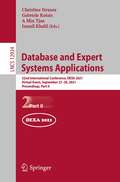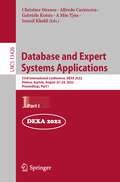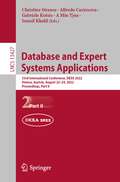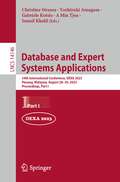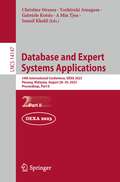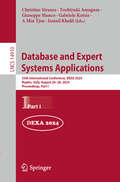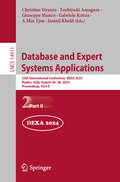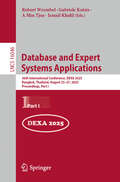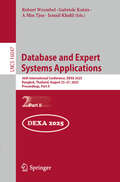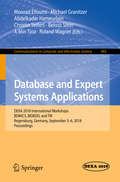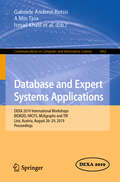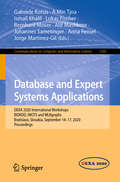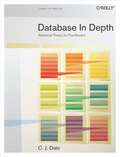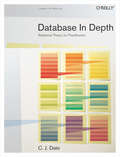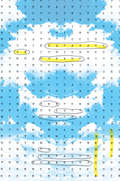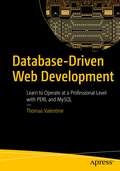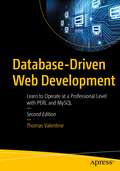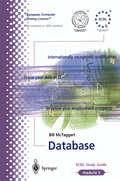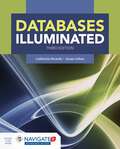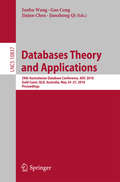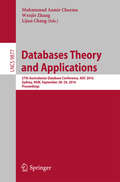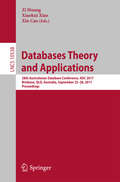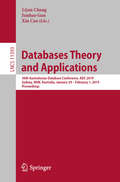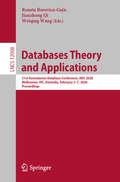- Table View
- List View
Database and Expert Systems Applications: 32nd International Conference, DEXA 2021, Virtual Event, September 27–30, 2021, Proceedings, Part II (Lecture Notes in Computer Science #12924)
by Ismail Khalil A Min Tjoa Christine Strauss Gabriele KotsisThis two-volume set, LNCS 12923 and 12924, constitutes the thoroughly refereed proceedings of the 5th International Conference on Database and Expert Systems Applications, DEXA 2021. Due to COVID-19 pandemic, the conference was held virtually. The 37 full papers presented together with 31 short papers in these volumes were carefully reviewed and selected from a total of 149 submissions. The papers are organized around the following topics: big data; data analysis and data modeling; data mining; databases and data management; information retrieval; prediction and decision support.
Database and Expert Systems Applications: 33rd International Conference, DEXA 2022, Vienna, Austria, August 22–24, 2022, Proceedings, Part I (Lecture Notes in Computer Science #13426)
by Alfredo Cuzzocrea Ismail Khalil A Min Tjoa Christine Strauss Gabriele KotsisThis two-volume set, LNCS 13426 and 13427, constitutes the thoroughly refereed proceedings of the 33rd International Conference on Database and Expert Systems Applications, DEXA 2022, held in Vienna in August 2022.The 43 full papers presented together with 20 short papers in these volumes were carefully reviewed and selected from a total of 120 submissions. The papers are organized around the following topics: Big Data Management and Analytics, Consistency, Integrity, Quality of Data, Constraint Modelling and Processing, Database Federation and Integration, Interoperability, Multi-Databases, Data and Information Semantics, Data Integration, Metadata Management, and Interoperability, Data Structures and much more.
Database and Expert Systems Applications: 33rd International Conference, DEXA 2022, Vienna, Austria, August 22–24, 2022, Proceedings, Part II (Lecture Notes in Computer Science #13427)
by Alfredo Cuzzocrea Ismail Khalil A Min Tjoa Christine Strauss Gabriele KotsisThis two-volume set, LNCS 13426 and 13427, constitutes the thoroughly refereed proceedings of the 33rd International Conference on Database and Expert Systems Applications, DEXA 2022, held in Vienna in August 2022.The 43 full papers presented together with 20 short papers in these volumes were carefully reviewed and selected from a total of 120 submissions. The papers are organized around the following topics: Big Data Management and Analytics, Consistency, Integrity, Quality of Data, Constraint Modelling and Processing, Database Federation and Integration, Interoperability, Multi-Databases, Data and Information Semantics, Data Integration, Metadata Management, and Interoperability, Data Structures and much more.
Database and Expert Systems Applications: 34th International Conference, DEXA 2023, Penang, Malaysia, August 28–30, 2023, Proceedings, Part I (Lecture Notes in Computer Science #14146)
by Ismail Khalil A Min Tjoa Christine Strauss Gabriele Kotsis Toshiyuki AmagasaThe two-volume set, LNCS 14146 and 14147 constitutes the thoroughly refereed proceedings of the 34th International Conference on Database and Expert Systems Applications, DEXA 2023, held in Penang, Malaysia, in August 2023.The 49 full papers presented together with 35 short papers were carefully reviewed and selected from a total of 155 submissions. The papers are organized in topical sections as follows:Part I: Data modeling; database design; query optimization; knowledge representation; Part II: Rule-based systems; natural language processing; deep learning; neural networks.
Database and Expert Systems Applications: 34th International Conference, DEXA 2023, Penang, Malaysia, August 28–30, 2023, Proceedings, Part II (Lecture Notes in Computer Science #14147)
by Ismail Khalil A Min Tjoa Christine Strauss Gabriele Kotsis Toshiyuki AmagasaThe two-volume set, LNCS 14146 and 14147 constitutes the thoroughly refereed proceedings of the 34th International Conference on Database and Expert Systems Applications, DEXA 2023, held in Penang, Malaysia, in August 2023.The 49 full papers presented together with 35 short papers were carefully reviewed and selected from a total of 155 submissions. The papers are organized in topical sections as follows:Part I: Data modeling; database design; query optimization; knowledge representation; Part II: Rule-based systems; natural language processing; deep learning; neural networks.
Database and Expert Systems Applications: 35th International Conference, DEXA 2024, Naples, Italy, August 26–28, 2024, Proceedings, Part I (Lecture Notes in Computer Science #14910)
by Giuseppe Manco Ismail Khalil A Min Tjoa Christine Strauss Gabriele Kotsis Toshiyuki AmagasaThe two-volume set LNCS 14910 and 14911 constitutes the proceedings of the 35th International Conference on Database and Expert Systems Applications, DEXA 2024, which took place in Naples, Italy, in August 2024. The 27 full and 20 short papers included in the proceedings set were carefully reviewed and selected from 102 submissions. They were organized in topical sections as follows: Part I: Financial and economic data analysis; graph theory and network analysis; database management and query optimization; machine learning and large language models; recommender systems and personalization; Part II: Blockchain and supply management; data mining and knowledge discovery; spatiotemporal data and mobility analysis; computer vision and image processing; data security and privacy; database indexing and query processing; specialized applications and case studies.
Database and Expert Systems Applications: 35th International Conference, DEXA 2024, Naples, Italy, August 26–28, 2024, Proceedings, Part II (Lecture Notes in Computer Science #14911)
by Giuseppe Manco Ismail Khalil A Min Tjoa Christine Strauss Gabriele Kotsis Toshiyuki AmagasaThe two-volume set LNCS 14910 and 14911 constitutes the proceedings of the 35th International Conference on Database and Expert Systems Applications, DEXA 2024, which took place in Naples, Italy, in August 2024. The 27 full and 20 short papers included in the proceedings set were carefully reviewed and selected from 102 submissions. They were organized in topical sections as follows: Part I: Financial and economic data analysis; graph theory and network analysis; database management and query optimization; machine learning and large language models; recommender systems and personalization; Part II: Blockchain and supply management; data mining and knowledge discovery; spatiotemporal data and mobility analysis; computer vision and image processing; data security and privacy; database indexing and query processing; specialized applications and case studies.
Database and Expert Systems Applications: 36th International Conference, DEXA 2025, Bangkok, Thailand, August 25–27, 2025, Proceedings, Part I (Lecture Notes in Computer Science #16046)
by Ismail Khalil A Min Tjoa Robert Wrembel Gabriele KotsisThe two-volume set LNCS 16046-16047 constitutes the proceedings of the 36th International Conference on Database and Expert Systems Applications, DEXA 2025, held in Bangkok, Thailand, in August 25–27, 2025. The 35 full and 22 short papers presented in this set together with 3 invited talks were carefully reviewed and selected from 123 submissions. They were organized in topical sections as follows: Part I: Industrial Keynote; Invited Talks; Large Language Models; Data Quality; Machine Learning /Artificial Intelligence Applications; Classification Techniques. Part II: Image Processing, Analytics, and Vision Systems; Recommender Techniques; Data Integration; Optimisation Methods; Graph Applications; Analytics; Security/Privacy; Benchmarks and Surveys.
Database and Expert Systems Applications: 36th International Conference, DEXA 2025, Bangkok, Thailand, August 25–27, 2025, Proceedings, Part II (Lecture Notes in Computer Science #16047)
by Ismail Khalil A Min Tjoa Robert Wrembel Gabriele KotsisThe two-volume set LNCS 16046-16047 constitutes the proceedings of the 36th International Conference on Database and Expert Systems Applications, DEXA 2025, held in Bangkok, Thailand, in August 25–27, 2025. The 35 full and 22 short papers presented in this set together with 3 invited talks were carefully reviewed and selected from 123 submissions. They were organized in topical sections as follows: Part I: Industrial Keynote; Invited Talks; Large Language Models; Data Quality; Machine Learning /Artificial Intelligence Applications; Classification Techniques. Part II: Image Processing, Analytics, and Vision Systems; Recommender Techniques; Data Integration; Optimisation Methods; Graph Applications; Analytics; Security/Privacy; Benchmarks and Surveys.
Database and Expert Systems Applications: DEXA 2018 International Workshops, BDMICS, BIOKDD, and TIR, Regensburg, Germany, September 3–6, 2018, Proceedings (Communications in Computer and Information Science #903)
by Mourad Elloumi Abdelkader Hameurlain Roland Wagner A Min Tjoa Michael Granitzer Christin Seifert Benno SteinThis volume constitutes the refereed proceedings of the three workshops held at the 29th International Conference on Database and Expert Systems Applications, DEXA 2018, held in Regensburg, Germany, in September 2018: the Third International Workshop on Big Data Management in Cloud Systems, BDMICS 2018, the 9th International Workshop on Biological Knowledge Discovery from Data, BIOKDD, and the 15th International Workshop on Technologies for Information Retrieval, TIR.The 25 revised full papers were carefully reviewed and selected from 33 submissions. The papers discuss a range of topics including: parallel data management systems, consistency and privacy cloud computing and graph queries, web and domain corpora, NLP applications, social media and personalization
Database and Expert Systems Applications: DEXA 2019 International Workshops BIOKDD, IWCFS, MLKgraphs and TIR, Linz, Austria, August 26–29, 2019, Proceedings (Communications in Computer and Information Science #1062)
by Mourad Elloumi Ismail Khalil A Min Tjoa Atif Mashkoor Anna Fensel Xabier Larrucea Michael Granitzer Christin Seifert Benno Stein Gabriele Anderst-Kotsis Johannes Sametinger Bernhard Moser Jorge Martinez-GilThis volume constitutes the refereed proceedings of the four workshops held at the 30th International Conference on Database and Expert Systems Applications, DEXA 2019, held in Linz, Austria, in August 2019: The 10th International Workshop on Biological Knowledge Discovery from Data, BIOKDD 2019, the 3rd International Workshop on Cyber-Security and Functional Safety in Cyber-Physical Systems, IWCFS 2019, the 1st International Workshop on Machine Learning and Knowledge Graphs, MLKgraphs2019, and the 16th International Workshop on Technologies for Information Retrieval, TIR 2019. The 26 selected papers discuss a range of topics including: knowledge discovery, biological data, cyber security, cyber-physical system, machine learning, knowledge graphs, information retriever, data base, and artificial intelligent.
Database and Expert Systems Applications: DEXA 2020 International Workshops BIOKDD, IWCFS and MLKgraphs, Bratislava, Slovakia, September 14–17, 2020, Proceedings (Communications in Computer and Information Science #1285)
by Ismail Khalil A Min Tjoa Atif Mashkoor Anna Fensel Johannes Sametinger Bernhard Moser Jorge Martinez-Gil Gabriele Kotsis Lukas FischerThis volume constitutes the refereed proceedings of the three workshops held at the 31st International Conference on Database and Expert Systems Applications, DEXA 2020, held in September 2020: The 11th International Workshop on Biological Knowledge Discovery from Data, BIOKDD 2020, the 4th International Workshop on Cyber-Security and Functional Safety in Cyber-Physical Systems, IWCFS 2020, the 2nd International Workshop on Machine Learning and Knowledge Graphs, MLKgraphs2019. Due to the COVID-19 pandemic the conference and workshop were held virtually. The 10 papers were thoroughly reviewed and selected from 15 submissions, and discuss a range of topics including: knowledge discovery, biological data, cyber security, cyber-physical system, machine learning, knowledge graphs, information retriever, data base, and artificial intelligent.
Database in Depth: Relational Theory for Practitioners
by C. J. DateThis book sheds light on the principles behind the relational model, which is fundamental to all database-backed applications--and, consequently, most of the work that goes on in the computing world today. Database in Depth: The Relational Model for Practitioners goes beyond the hype and gets to the heart of how relational databases actually work. Ideal for experienced database developers and designers, this concise guide gives you a clear view of the technology--a view that's not influenced by any vendor or product. Featuring an extensive set of exercises, it will help you: understand why and how the relational model is still directly relevant to modern database technology (and will remain so for the foreseeable future) see why and how the SQL standard is seriously deficient use the best current theoretical knowledge in the design of their databases and database applications make informed decisions in their daily database professional activities Database in Depth will appeal not only to database developers and designers, but also to a diverse field of professionals and academics, including database administrators (DBAs), information modelers, database consultants, and more. Virtually everyone who deals with relational databases should have at least a passing understanding of the fundamentals of working with relational models. Author C.J. Date has been involved with the relational model from its earliest days. An exceptionally clear-thinking writer, Date lays out principle and theory in a manner that is easily understood. Few others can speak as authoritatively the topic of relational databases as Date can.
Database in Depth: Relational Theory for Practitioners
by C. J. DateThis book sheds light on the principles behind the relational model, which is fundamental to all database-backed applications--and, consequently, most of the work that goes on in the computing world today. Database in Depth: The Relational Model for Practitioners goes beyond the hype and gets to the heart of how relational databases actually work.Ideal for experienced database developers and designers, this concise guide gives you a clear view of the technology--a view that's not influenced by any vendor or product. Featuring an extensive set of exercises, it will help you:understand why and how the relational model is still directly relevant to modern database technology (and will remain so for the foreseeable future)see why and how the SQL standard is seriously deficientuse the best current theoretical knowledge in the design of their databases and database applicationsmake informed decisions in their daily database professional activitiesDatabase in Depth will appeal not only to database developers and designers, but also to a diverse field of professionals and academics, including database administrators (DBAs), information modelers, database consultants, and more. Virtually everyone who deals with relational databases should have at least a passing understanding of the fundamentals of working with relational models.Author C.J. Date has been involved with the relational model from its earliest days. An exceptionally clear-thinking writer, Date lays out principle and theory in a manner that is easily understood. Few others can speak as authoritatively the topic of relational databases as Date can.
Database of Dreams
by Rebecca LemovJust a few years before the dawn of the digital age, Harvard psychologist Bert Kaplan set out to build the largest database of sociological information ever assembled. It was the mid-1950s, and social scientists were entranced by the human insights promised by Rorschach tests and other innovative scientific protocols. Kaplan, along with anthropologist A. I. Hallowell and a team of researchers, sought out a varied range of non-European subjects among remote and largely non-literate peoples around the globe. Recording their dreams, stories, and innermost thoughts in a vast database, Kaplan envisioned future researchers accessing the data through the cutting-edge Readex machine. Almost immediately, however, technological developments and the obsolescence of the theoretical framework rendered the project irrelevant, and eventually it was forgotten.
Database of Piano Chords: An Engineering View of Harmony (SpringerBriefs in Electrical and Computer Engineering)
by Lorenzo J. Tardón Emilio Molina Isabel Barbancho Ana M. BarbanchoDatabase of Piano Chords: An Engineering View of Harmony includes a unique database of piano chords developed exclusively for music research purposes, and outlines the key advantages to using this dataset to further one's research. The book also describes the physical bases of the occidental music chords and the influence used in the detection and transcription of the music, enabling researchers to intimately understand the construction of each occidental chord. The online database contains more than 275,000 chords with different degrees of polyphony and with different playing styles. Together, the database and the book are an invaluable tool for researchers in this field.
Database-Driven Web Development: Learn to Operate at a Professional Level with PERL and MySQL
by Thomas ValentineLearn to operate at a professional level with HTML, CSS, DOM, JavaScript, PERL and the MySQL database. With plain language explanations and step-by-step examples, you will understand the key facets of web development that today’s employers are looking for. Encapsulating knowledge that is usually found in many books rather than one, this is your one-stop tutorial to becoming a web professional.You will learn how to use the PERL scripting language and the MySQL database to create powerful web applications. Each chapter will become progressively more challenging as you progress through experimentation and ultimately master database-driven web development via the web applications studied in the last chapters.Including practical tips and guidance gleaned from 20+ years of working as a web developer, Thomas Valentine provides you with all the information you need to prosper as a professional database-driven web professional.What You'll LearnLeverage standard web technologies to benefit a database-driven approachCreate an effective web development workstation with databases in mindUse the PERL scripting language and the MySQL database effectivelyMaximize the Apache Web Server Who This Book Is For The primary audience for this book are those who know already know web development basics and web developers who want to master database driven web development. The skills required to understand the concepts put forth are a working knowledge of PERL and basic MySQL.
Database-Driven Web Development: Learn to Operate at a Professional Level with PERL and MySQL
by Thomas ValentineThis book will teach you the essential knowledge required to be a successful and productive web developer with the ability to produce cutting-edge websites utilizing a database. This updated edition starts with the fundamentals of web development before delving into Perl and MySQL concepts such as script and database modelling, script-driven database interactions, content generation from a database, and information delivery from the server to the browser and vice versa. The only skills required to get the most from this book are basic knowledge of how the Internet works and a novice skill level with Perl and MySQL. The rest is intuitively presented code that most people can quickly and easily understand and employ. An extensive selection of practical, fully functional programming constructs in six different programming languages will give you the knowledge and tools required to create eye-catching, capable, and functionally impressive database-driven websites. Author Thomas Valentine has taken the concepts presented in the first edition of this book to new heights, offering in-depth discussions of each area of functionality required to develop fully formed database-driven web applications. He has expanded on the examples presented in the first edition and has included some very interesting and useful programming techniques for your consideration. Upon completing this book, you’ll have gained the benefit of the author’s decades worth of experience and will be able to apply your new knowledge and skills to your own projects. What You Will Learn Install, configure and use a trio of software packages (Apache Web Server, MySQL Database Server, and Perl Scripting Server)Create an effective web development workstation with databases in mindUse the PERL scripting language and MySQL databases effectivelyMaximize the Apache Web Server Who This Book Is For Those who already know web development basics and web developers who want to master database-driven web development. The skills required to understand the concepts put forth in this book are a working knowledge of PERL and basic MySQL.
Database: Ecdl - The European Pc Standard (European Computer Driving Licence Ser. #5)
by Bill McTaggartPreface This book is intended to help you successfully complete the test for Module 5 of the European Computer Driving Licence (ECDL). However before we start working through the actual content of the guide you may find it useful to know a little bit more about the ECDL in general and where this particular Module fits into the overall framework. What Is The ECDL? The European Computer Driving Licence (ECDL) is a European-wide qualification that enables people to demonstrate their competence in computer skills. It certifies the candidate's knowledge and competence in personal computer usage at a basic level and is based upon a single agreed syllabus. This syllabus covers a range of specific knowledge areas and skill sets, which are broken down into seven modules. Each of the modules must be passed before the ECDL certificate can be awarded, though they may be taken in any order but must be completed within a three year period. Testing of candidates is at audited testing centres, and successful completion of the test will demonstrate the holder's basic knowledge and competence in using a personal computer and common computer applications. The implementation of the ECDL in the UK is being managed by the British Computer Society. It is growing at a tremendous rate and is set to become the most widely recognised qualification in the field of work-related computer use.
Databases Illuminated
by Catherine M. Ricardo Susan D. UrbanDatabases Illuminated, Third Edition Includes Navigate 2 Advantage Access combines database theory with a practical approach to database design and implementation. Strong pedagogical features, including accessible language, real-world examples, downloadable code, and engaging hands-on projects and lab exercises create a text with a unique combination of theory and student-oriented activities. Providing an integrated, modern approach to databases, Databases Illuminated, Third Edition is the essential text for students in this expanding field.
Databases Theory and Applications: 26th Australasian Database Conference, Adc 2015, Melbourne, Vic, Australia, June 4-7, 2015. Proceedings (Theoretical Computer Science and General Issues #9093)
by Jinjun Chen Gao Cong Junhu Wang Jianzhong QiThis book constitutes the refereed proceedings of the 29th Australasian Database Conference, ADC 2018, held in Gold Coast, QLD, Australia, in May 2018.The 23 full papers plus 6 short papers presented together with 3 demo papers were carefully reviewed and selected from 53 submissions. The Australasian Database Conference is an annual international forum for sharing the latest research advancements and novel applications of database systems, data-driven applications, and data analytics between researchers and practitioners from around the globe, particularly Australia and New Zealand.
Databases Theory and Applications: 27th Australasian Database Conference, ADC 2016, Sydney, NSW, September 28-29, 2016, Proceedings (Lecture Notes in Computer Science #9877)
by Muhammad Aamir Cheema Wenjie Zhang Lijun ChangThis book constitutes the refereed proceedings of the 26th Australasian Database Conference, ADC 2015, held in Melbourne, VIC, Australia, in June 2015. The 24 full papers presented together with 5 demo papers were carefully reviewed and selected from 43 submissions. The Australasian Database Conference is an annual international forum for sharing the latest research advancements and novel applications of database systems, data driven applications and data analytics between researchers and practitioners from around the globe, particularly Australia and New Zealand. The mission of ADC is to share novel research solutions to problems of today's information society that fulfill the needs of heterogeneous applications and environments and to identify new issues and directions for future research. ADC seeks papers from academia and industry presenting research on all practical and theoretical aspects of advanced database theory and applications, as well as case studies and implementation experiences.
Databases Theory and Applications: 28th Australasian Database Conference, ADC 2017, Brisbane, QLD, Australia, September 25–28, 2017, Proceedings (Lecture Notes in Computer Science #10538)
by Zi Huang, Xiaokui Xiao and Xin CaoThis book constitutes the refereed proceedings of the 28th Australasian Database Conference, ADC 2017, held in Brisbane, QLD, Australia, in September 2017. The 20 full papers presented together with 2 demo papers were carefully reviewed and selected from 32 submissions. The mission of ADC is to share novel research solutions to problems of today’s information society that fulfill the needs of heterogeneous applications and environments and to identify new issues and directions for future research and development work. The topics of the presented papers are related to all practical and theoretical aspects of advanced database theory and applications, as well as case studies and implementation experiences.
Databases Theory and Applications: 30th Australasian Database Conference, ADC 2019, Sydney, NSW, Australia, January 29 – February 1, 2019, Proceedings (Lecture Notes in Computer Science #11393)
by Lijun Chang Xin Cao Junhao GanThis book constitutes the refereed proceedings of the 30th Australasian Database Conference, ADC 2019, held in Sydney, NSW, Australia, in January/February 2019. The 9 full papers presented together with one demo paper were carefully reviewed and selected from 19 submissions. The Australasian Database Conference is an annual international forum for sharing the latest research progresses and novel applications of database systems, data management, data mining and data analytics for researchers and practitioners in these areas from Australia, New Zealand and in the world
Databases Theory and Applications: 31st Australasian Database Conference, ADC 2020, Melbourne, VIC, Australia, February 3–7, 2020, Proceedings (Lecture Notes in Computer Science #12008)
by Jianzhong Qi Renata Borovica-Gajic Weiqing WangThis book constitutes the refereed proceedings of the 31th Australasian Database Conference, ADC 2019, held in Melbourne, VIC, Australia, in February 2020. The 14 full and 5 short papers presented were carefully reviewed and selected from 30 submissions. The Australasian Database Conference is an annual international forum for sharing the latest research advancements and novel applications of database systems, data driven applications and data analytics between researchers and practitioners from around the globe, particularly Australia, New Zealand and in the World.
